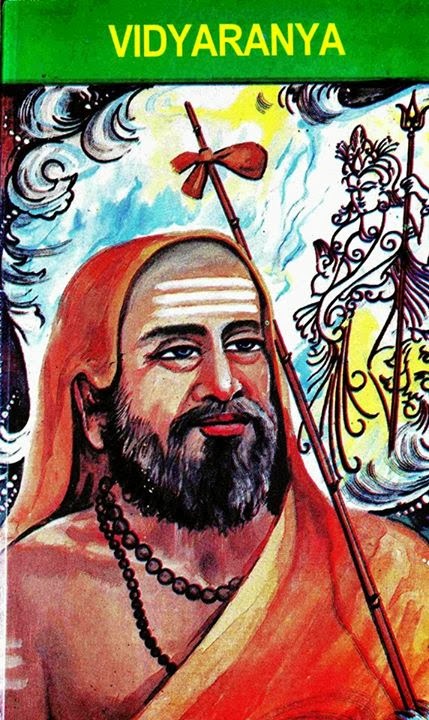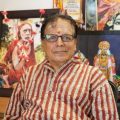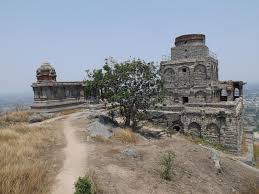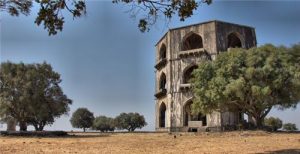

The two patriotic saints of Hinduism. – J K SIVAN
No Hindu can afford to forget the two names in History of India. Swami Vidyaranya, jagadguru of the Sringeri Sharada Peetham (1374–1386 )- who was responsible for establishment of Vijayanagar empire, samrajya. Another great Mahan was Samarth Ramdas, who was behind the successful kingdom of Chatrapathi Sivaji in Maharashtra. The Math records of Sringeri state that Vidyaranya was the elder brother of Bharati Tirtha, who preceded him as the acharya of Sringeri. Vidyaranya composed, or contributed to, a number of texts. The Panchadashi may have been finished by Bharati Tirtha, and some sources argue that Vidyaranya and Bharati Tirtha were one and he same person.
Harihara Raya I and Bukka Raya I were two brothers belonging to the Kakatiya dynasty, serving the Kampili chief. After Kampili fell to the Muslim invasion, they were taken to Delhi and converted to Islam. They were sent back to Kampili as the Delhi Sultan’s vassals. After gaining power in the region, they met Vidyaranya, who converted them back to the Hindu faith. After receiving his blessings, they founded their kingdom.
Vidyaranya had a central role in repositioning Shankara and his view on Advaita Vedanta.
Vidyaranya’s Pañcadaśī is a standard text on the philosophy of the Advaita Vedanta tradition. It consists of fifteen chapters which are divided into three sections of five chapters each, which are designated as Viveka (Discrimination), Deepa (Illumination) and Ananda (Bliss). The text elucidates many Vedantic concepts, such as, the five sheaths of individuality, the relation between Isvara (God), Jagat (world) and Jiva (individual), the indistinguishability of cause and effect, etc. Jivanmuktiviveka was composed at about 1380, after Madhava had become a sannyasin. Vidyaranya also wrote a commentary on the Mimamsa Sutras. The inspiration and the driving force behind the establishment of Vijayanagara Empire by Harihara I and Bukkaraya was Sri Vidyaranya.Therefore, the fifth installment of the Guru Poornima series is dedicated to Sri Vidyaranya.Vidyaranya was born in present day Warangal, Andra Pradesh and became the 11th Shankaracharya of Sringeri Peetham in 1333. It is believed that Vidyaranya was none other than Madhavacharya, the elder brother of Sayanacharya; both of whom were ministers in Vijayanagara court and that Madhavacharya served in the court of Harihara I, Bukkaraya and briefly under Harihara II, before taking up Sannyasa in 1380. He took the monastic name Vidyaranya. Statements and reports vary on these old issues.
When the kingdoms were attacked by Muhammad bin Tughlaq, it is believed that they captured and converted Harihara I and Bukkaraya into Islam and sent them back as vassals. During that time, Sri Vidyaranya was staying at Matanga Hill and the brothers came there and met him. Under the guidance of Sri Vidyaranya, the brothers returned back to Hinduism and founded the Vijayanagara Empire.Vidyaranya got many temples built and renovated, and he re-started worship in many temples wherein worship had been suspended. He was instrumental in building the infrastructure for Sringeri Peetham, which helped the peetham to sustain and spread its dharmic activities for many centuries It is learnt that Vidyaranya was born on 11 April, 1296 to Mayanacharyulu (A distinguished scholar of Vedas) and SriMati Devi. His original name was Madhavarya. His role in arresting Islamisation of South India was really very great.
It’s might was destroyed by the combined armies of South Indian Muslim states Bijapur, Bidar, Giaconda and Ahmednagar (Birar did not take part in the war) at Tallikota battle fought on 25 December 1564. Araveeti (aliya) Rama Raya the defacto emperor of Vijaynagar led the battle agsint the Muslim army. Sadsivarayalu was the actual emperor. The battle was ferocious and the scales were tilting in favor of Hindu army when the Muslim commanders in the army of Vijaynagar committed treason and switched over to the combined Muslim armies of the Sultans along with their troops. Rama raya lost the day and was captured and killed immediately. There is a saying that any thing rising has to come down. The cities of Vijaynagar and Hampi were ransacked by the victorious Muslim armies. Earlier the royal families left the city for Penukonda with treasures leaving the people to their fate. Muslim troops stayed in the city for five months and destroyed and burnt everything by burning and breaking with hammers and crow bars with vengeance. The ferocity of destruction has no parallel and was unwarranted. No other proof in this world is required for the Hindu hatred among Muslims in the bye gone years. They killed innumerable people without discrimination. With this, the cities lost all its glory. The capital was changed to Penukonda (Anantapur District) and to Chandragiri (Chittoor District). The Vijayanagar Empire although survived for another 80 years lost its glory and faded into pages of history in 1646 plagued by feuds in dynastic succession by the short sighted rulers, treason by the vassals and rift between the minor principalities that ruined cohesion. Its last ruler was Sri Rangaraya III who in spite of valiant efforts failed to stem the rot. His vassals betrayed him. The Empire ceased to exist in 1646. Sri Ranga III probably died in 1680 devoid of empire. South India was thus saved from Islamisation by the kings of Vijayanagar. Hampi and Vijayanagar are now in ruins and are world heritage sites (3). The history of Vijaynagar gathered dust and people completely forgot about the empire till Robert Sewell, the former District collector of Bellary during the British rule gathered information on the empire and wrote the famous outstanding book, “The forgotten Empire”. He did a pioneering work and world is indeed is indebted to him. It is a shame and utter disgrace that Indians forgot about their own once glorious empire and had to be told by a European about their own history. It is believed that Swami Vidyaranya predicted at the time of building the city of Vijayanagar that the empire that is being established would last for three centuries. His prediction came true and the empire vanished after three centuries.
There is only one parallel to Swami Vidyaranya in the history of India. It was saint (Sant) Ramdas who lived in Maharshtra State and was the spiritual guide to Chhatrapati ( King of Kings) Shivaji who was inspired by the saint and established an independent Hindu Maratha kingdom in Maharshtra under the very nose of evil emperor Aurangzeb in the 17 th century. He protected Hindu faith from the marauding Mughals and saved Hindus from persecution and forced conversions in those evil years. Maratha Empire grew to great heights in a course of few years and was in a position to even dictate terms to Mughals who by this time became weak in 18 th century. Marathas were a great bottle neck for the spread of influence of East India Company in India till they were defeated in third Panipat war (1761) by the forces of Afghan ruler Ahmed Shah Abdali Durrani. Shivaji Maharaj (Great king) is very greatly revered in India and is considered as the incarnation of Lord Shiva (14).Sant Ramdas and Swami Vidyaranya are comparable in Indian History towards their commitment for protection and revival of Hinduism and faith in the face of low Hindu morale and severe persecution by Muslims.
The magnum opus of Vidyaranya was the explanations for Vedas which no one has undertaken including Adi Sankaracharya and this is known as Sayana veda Bhashyam. Vidyaranya Swami identified causes for Hindu down fall as a result of interaction with Islam and these are explained in the great book Prayaschitta Suddhanidhi ( A treasure of atonement for the sins). He realized the importance and need for revitalizing the Hindus and build faith and inspire them about their own religion. He foresaw that unless they were fully aware of the greatness of their religion, they would be attracted towards Islam. Writing of Veda Bhashyam was an effort towards this.





